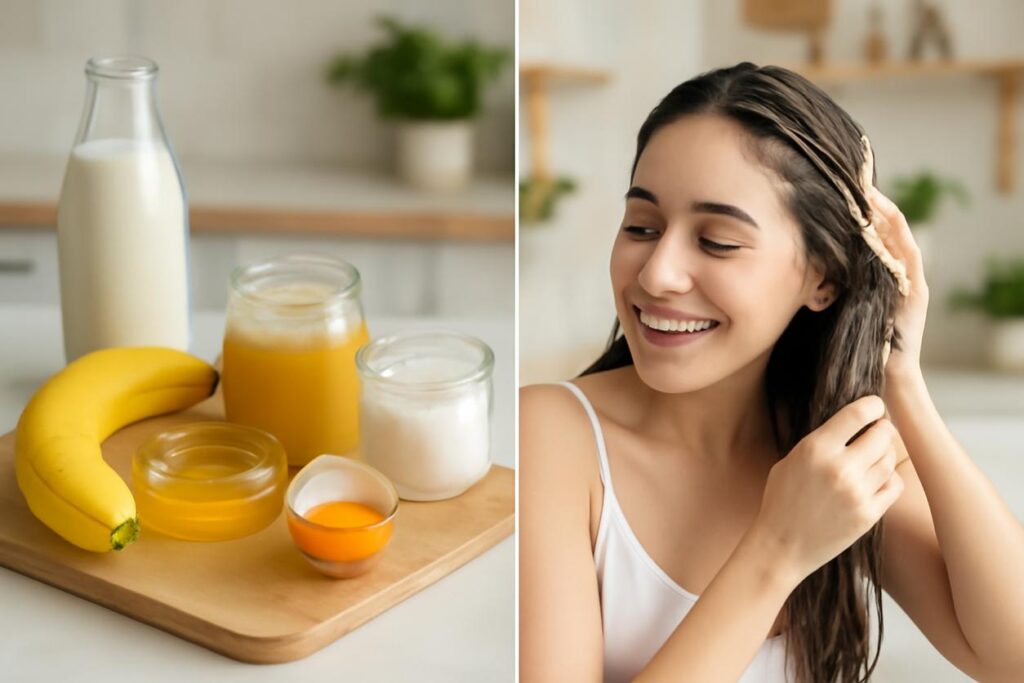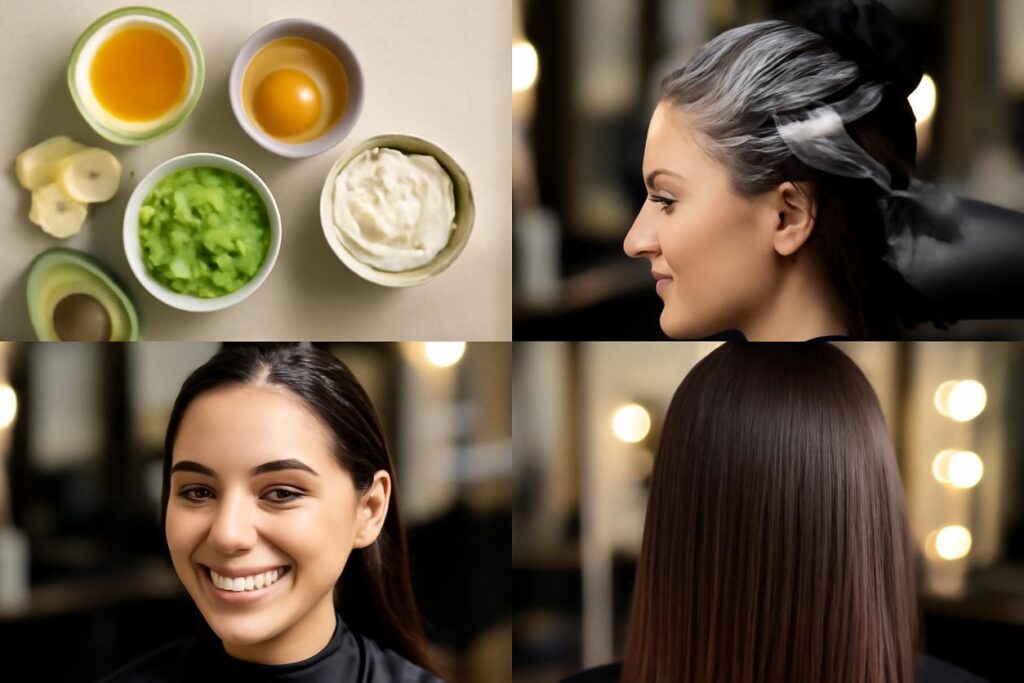The Ultimate Guide to a DIY Hair Mask: Pantry Recipes for 2025
Welcome to your complete guide to creating the perfect DIY hair mask right from your kitchen. Forget expensive salon treatments and complex chemical formulas. The path to healthier, shinier hair might just be sitting in your pantry. This guide, updated for 2025, is designed for home haircare enthusiasts and beginners who want natural, effective solutions tailored to their unique hair needs.
We will walk you through identifying your hair type, choosing the right ingredients, and mixing up simple yet powerful masks. Get ready to unlock the secrets of natural hair care with a simple, effective, and budget-friendly DIY hair mask.
Table of Contents
- Why make a homemade hair mask?
- How to choose ingredients for your hair type
- Key pantry ingredients and their effects
- Three starter recipes for different concerns
- Customizing recipes by hair length and texture
- Timing, application technique and heat methods
- How often to use a DIY mask and what to expect
- Quick troubleshooting and safety tips
- Ingredient swaps and budget-friendly alternatives
- Evidence summary and further reading
- Quick reference: single-page recipe card
Why make a homemade hair mask?
Choosing to create a homemade hair treatment is more than just a fun weekend project. It’s a conscious choice for your hair’s health and your wallet. Here are a few compelling reasons to embrace the world of the DIY hair mask:
- Ingredient Control: You know exactly what you are putting on your hair and scalp. There are no hidden silicones, parabens, or sulfates. This is especially beneficial for those with sensitive skin or allergies.
- Cost-Effective: High-quality hair masks can be expensive. By using common pantry items, you can achieve similar, and sometimes better, results for a fraction of the cost.
- Tailored to You: Your hair is unique. A DIY hair mask allows you to create a custom-blend treatment that targets your specific concerns, whether it’s dryness, damage, or an irritated scalp.
- Freshness and Potency: You are using fresh ingredients without preservatives, meaning your hair gets the maximum nutritional benefit from the vitamins, minerals, and fatty acids present in the food.
How to choose ingredients for your hair type
The secret to a successful DIY hair mask lies in selecting ingredients that cater to your hair’s specific needs. The first step is to understand your hair’s characteristics, particularly its porosity.
Identifying your hair porosity and needs
Hair porosity refers to your hair’s ability to absorb and retain moisture. It is a crucial factor in determining whether your hair needs more protein or more moisture.
- Low Porosity: The hair cuticle is tightly packed. Hair takes a long time to get wet and a long time to dry. It is prone to product buildup because products tend to sit on top of the hair rather than being absorbed. Needs: Lightweight oils and humectants like honey and aloe vera. Avoid heavy proteins that can cause stiffness.
- Medium (Normal) Porosity: The cuticle is looser, allowing moisture to penetrate easily and be retained well. This hair type is the easiest to care for and benefits from a balance of moisture and protein.
- High Porosity: The hair cuticle has gaps or holes, which can be due to genetics or damage from chemical treatments and heat. It absorbs moisture quickly but also loses it just as fast, leading to frizz and dryness. Needs: Sealing oils, butters, and protein treatments to help fill the gaps in the cuticle and lock in moisture.
A simple, though not perfectly scientific, way to test porosity is the float test. Place a clean strand of hair in a glass of water. If it floats, you likely have low porosity. If it sinks slowly, you have medium porosity. If it sinks quickly, you have high porosity.
Key pantry ingredients and their effects
Your kitchen is a treasure trove of hair-loving ingredients. Understanding what each one does will help you become a master at crafting the perfect DIY hair mask for your needs.
Oils: characteristics and best uses
Oils are fantastic for sealing in moisture and adding shine. Some penetrate the hair shaft, while others coat it.
- Coconut Oil: Rich in lauric acid, it is one of the few oils that can penetrate the hair shaft to reduce protein loss. Best for medium to high porosity hair. It can be too heavy for fine or low-porosity hair.
- Olive Oil: An excellent emollient, it smooths the outer cuticle and adds softness and shine. It contains oleic acid and squalene, which are great for conditioning. Suitable for most hair types, especially dry and thick hair.
- Avocado Oil: A lightweight oil packed with vitamins A, D, and E, and fatty acids. It absorbs well, making it suitable for low to medium porosity hair.
Proteins and binders: when to use them
Protein treatments help to fortify the hair shaft, especially if it’s damaged or has high porosity. Binders help give your mask a good consistency.
- Egg: The yolk is rich in fats and vitamins, making it a great moisturizer. The white is full of protein, ideal for strengthening hair. Use a whole egg for normal hair, just the yolk for dry hair, and just the white for oily hair.
- Greek Yogurt: Contains lactic acid to cleanse the scalp and proteins to strengthen hair. It is a gentler protein option than eggs.
- Banana: Rich in potassium, natural oils, and vitamins, bananas help soften the hair and protect its natural elasticity, preventing split ends and breakage. They are also a great binder for your mask.
Hydrators and humectants: gentle options
Humectants are ingredients that attract moisture from the air and draw it into the hair shaft, providing excellent hydration.
- Honey: A natural humectant and emollient, honey attracts moisture and helps to smooth the hair cuticle, adding shine. It also has natural antibacterial properties, which can benefit scalp health.
- Aloe Vera Gel: Packed with vitamins, enzymes, and minerals, aloe vera conditions the hair, soothes the scalp, and can help reduce dandruff. Its molecular structure is similar to keratin, the primary protein of hair.
- Avocado: Not just a source of oil, the fruit itself is incredibly moisturizing due to its high content of fatty acids and vitamins. It makes hair feel soft and manageable.
Three starter recipes for different concerns
Ready to start mixing? Here are three easy recipes to tackle common hair issues. For each DIY hair mask, simply blend the ingredients until smooth to avoid lumps in your hair.
Hydration boost for dry hair
This mask is a drink of water for thirsty strands, leaving them soft, shiny, and manageable.
- Ingredients: 1/2 ripe avocado, 1 tablespoon olive oil, 1 tablespoon honey.
- Why it works: Avocado and olive oil provide deep moisture and fatty acids, while honey acts as a humectant to draw in and seal that moisture.
- Instructions: Mash the avocado until completely smooth. Stir in the olive oil and honey until you have a creamy paste. Apply to clean, damp hair from roots to ends. Leave on for 20-30 minutes.
Strengthening mask for weak or brittle strands
If your hair is feeling weak from heat styling or processing, this protein-rich mask can help restore its strength.
- Ingredients: 1 egg, 2 tablespoons plain Greek yogurt, 1 tablespoon coconut oil (melted).
- Why it works: The egg provides a strong dose of protein to patch up weak spots in the hair cuticle. Yogurt offers a gentler protein boost and lactic acid, while coconut oil penetrates to prevent further protein loss.
- Instructions: Whisk the egg and yogurt together. Slowly drizzle in the melted coconut oil while whisking to combine. Apply to damp hair, focusing on the mid-lengths and ends. Leave on for 15-20 minutes. Do not use hot water to rinse, as it can cook the egg.
Scalp-soothing mask for irritation
A calm scalp is the foundation of healthy hair. This mask helps to soothe itchiness and reduce flakes.
- Ingredients: 2 tablespoons aloe vera gel, 1 tablespoon honey, a few drops of tea tree oil (optional, for its antifungal properties).
- Why it works: Aloe vera is a natural anti-inflammatory that soothes and hydrates the scalp. Honey is antibacterial and moisturizing. Tea tree oil can help combat dandruff-causing microbes.
- Instructions: Mix the aloe vera gel and honey. If using, add 2-3 drops of tea tree oil and stir well. Apply directly to the scalp with your fingertips, gently massaging it in. Leave on for 20 minutes before shampooing.
Customizing recipes by hair length and texture
The recipes above are a starting point. Feel free to adjust quantities based on your hair.
- Short or Fine Hair: Use half the amount of the recipe to avoid weighing your hair down. Focus on lighter ingredients like aloe vera and yogurt.
- Long or Thick Hair: You may need to double the recipe to ensure full coverage. Richer ingredients like avocado, banana, and coconut oil work well for thick, coarse hair.
Always aim for a smooth, yogurt-like consistency. If a mask is too thick, add a little water or aloe vera. If it’s too thin, add more of the base ingredient, like banana or avocado.
Timing, application technique and heat methods
How you apply your DIY hair mask can make a big difference.
Application: For best results, apply your mask to clean, damp (towel-dried) hair. This allows the ingredients to penetrate more effectively than on dry or dirty hair. Section your hair and apply the mask evenly from roots to ends using your fingers or a brush. Pay special attention to the ends, which are usually the most damaged.
Timing: Most homemade hair masks should be left on for 20 to 30 minutes. Protein-based masks (with egg or yogurt) should not be left on for longer than 20 minutes to avoid making the hair stiff.
Heat Methods: Applying gentle heat helps to open the hair cuticle, allowing the mask to penetrate deeper. You can do this by covering your hair with a shower cap and then wrapping a warm, damp towel around it. Let it sit for the duration of the treatment.
How often to use a DIY mask and what to expect
Consistency is key, but overdoing it can lead to buildup or protein overload. Here’s a general guideline:
- For dry or damaged hair: A moisturizing DIY hair mask can be used once a week.
- For normal hair: Use a mask every two weeks to maintain health and shine.
- For protein-sensitive or low-porosity hair: Limit protein-heavy masks to once a month.
What to Expect: After the first use, you should notice your hair feels softer and looks shinier. Over time, with consistent use, you can expect improved elasticity, less breakage, and better overall hair health. Remember, natural remedies work with your hair’s biology, and lasting results come with patience.
Quick troubleshooting and safety tips
- Greasy Residue: If your hair feels greasy after rinsing, you may have used too much oil. Ensure you are shampooing thoroughly after the treatment. Rinsing with lukewarm water is more effective at removing oil than cold water.
- Stiff or Brittle Hair: This can be a sign of “protein overload.” You’ve used too much protein for your hair’s needs. Counteract this with a purely moisturizing mask (like the avocado and honey recipe) at your next treatment.
- Allergies: Always perform a patch test before applying a new ingredient to your entire head. Apply a small amount of the mixture to your inner elbow or behind your ear and wait 24 hours to check for any irritation.
Ingredient swaps and budget-friendly alternatives
You don’t need to run to the store if you’re missing an ingredient. Many items can be swapped.
- No Avocado? Use a ripe banana for a similar creamy, moisturizing base.
- Out of Olive Oil? Almond oil, grapeseed oil, or sunflower oil can be great alternatives.
- Don’t have Greek Yogurt? Coconut milk or mayonnaise (which contains eggs and oil) can be used for a protein and fat boost. Mayonnaise works surprisingly well as a ready-made strengthening DIY hair mask.
Evidence summary and further reading
The benefits of using natural ingredients in a DIY hair mask are rooted in their nutritional composition. Oils rich in fatty acids help lubricate the hair shaft, reducing friction and breakage. Proteins like those in eggs and yogurt temporarily patch gaps in the hair’s cuticle, adding strength. Humectants like honey and aloe vera bind water to the hair, increasing its moisture content.
While large-scale clinical trials on specific pantry recipes are rare, the science behind individual components is well-documented in cosmetology and nutritional science. For those interested in learning more about how specific nutrients support hair, we recommend resources like Rich Hair UK for general hair health information and this guide from the NHS on Hair Nutrition which explains the connection between diet and hair health.
Quick reference: single-page recipe card
For your convenience, here is a quick summary of the starter recipes.
| Mask Type | Ingredients | Best For | Leave-In Time |
|---|---|---|---|
| Hydration Boost | 1/2 Avocado, 1 tbsp Olive Oil, 1 tbsp Honey | Dry, dull hair | 20-30 minutes |
| Strengthening | 1 Egg, 2 tbsp Greek Yogurt, 1 tbsp Coconut Oil | Weak, brittle, or damaged hair | 15-20 minutes |
| Scalp Soothing | 2 tbsp Aloe Vera Gel, 1 tbsp Honey | Itchy, irritated scalp | 20 minutes |






